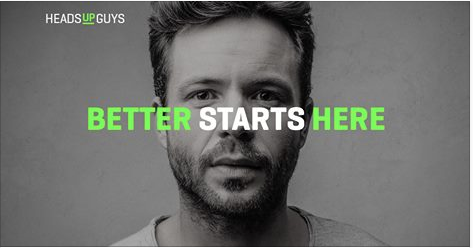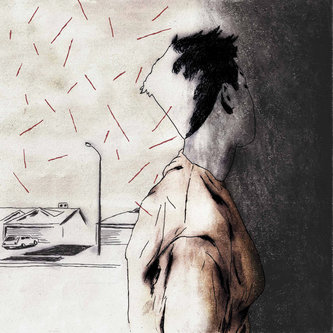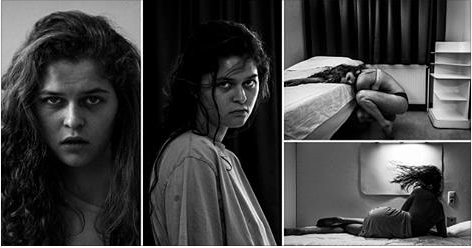
|
Writer and youthworker, Michael Lee, speaks openly about addiction, in his poem "The Addict, A Magician". Through his stunning use of words, Lee touches on his own personal battles with alcohol, as well as the impact of losing a loved one to drugs had on him and his perspective on life. Check it out below! "The mind of the addict is cunning enough to convince the body it is not dying... Addiction is the ethereal art of forgetting that you are still here... The difference between an addict and one who is drowning is the one who is drowning knows it. The addict will drink the sea until it becomes him"  For all the men out there, this is for you! While many joke about men avoiding the doctor, a new resource designed specifically for guys aims to increase mens' awareness of their mental health and of the signs of depression. In Canada, men are much more likely to go undiagnosed with depression, and they have a higher rate of completed suicides than their female counterparts. Due to these statistics, the Men’s Depression and Suicide Network, a "Canada-wide initiative to develop resources, services, and programs to improve the mental health and well-being of men", was born. As part of the initiative, which is based out of The University of British Columbia (UBC), an online resource called HeadsUpGuys was developed, which works to educate men about the symptoms, risk factors and triggers of depression and suicide. The website also includes a "self-check" screening tool, tips and information regarding stress management, personal stories and experiences from men who have faced depression, and plenty of resources and links to seek additional support and treatment. Check it out now and share with all the guys you know! http://headsupguys.ca/ https://www.facebook.com/HeadsUpGuys.ca?fref=ts  In the controversial and powerful article, "Freedom, Finally, After A Life in Prison", we learn about Paula Cooper, a woman who was charged with murder in her adolescence and initially was sentenced to die in the electric chair had a family member of the individual she killed not campaigned to have her sentence changed. During her decades in prison Cooper seemed to have transformed her life and she was finally released in 2013, years early due to good behaviour. Though it took some getting used to the world outside of prison, from the outside looking in Cooper seemed to be doing well and worked hard to make a new life for herself. However, deep down she still struggled with overwhelming guilt from the incident that landed her in prison and depression that had stemmed from a traumatic and troublesome childhood. Eventually, it all became too much and in May of this year, Cooper took her own life. More than anything, this article points out the flaws in our mental healthcare system, particularly with respect to the lack of psychiatric treatment and support in prison and especially when individuals are released, which for any individual is a difficult adjustment, but can be heightened for those with a history filled with trauma, torment and mental health issues. "Mental health care in prison is mostly a pill in a paper cup. Ms. Cooper herself was briefly on antidepressants, she told her sister. No one mandated follow-up treatment for “re-entry,” an apt term considering how much it must feel like dropping from outer space. “Nobody helps because people don’t see us as human beings,” Ms. Cooper said... We need to provide mental health assessments; adequate counseling and treatment programs; rehabilitation; and appropriate medication, as opposed to just sedatives. We should make outpatient treatment a condition of parole, and expand the use of specialized mental health “re-entry courts,” which offer intensive guidance and support."  Young photographer Laura Hospes was recently admitted to a psychiatric facility in the Netherlands for treatment of depression, anxiety and disordered eating, following a suicide attempt. During her stay, Hospes used her camera to help make sense of and bring some clarity to the confusing and overwhelming emotions she felt. Though initially the project was aimed at rediscovering herself and acted as a form of healing and therapy, Hospes later decided to share her photo series, entitled UPC-UMCG, on social media in the hopes that it may touch others who have also struggled with mental illness and spent time in a psychiatric ward. “At first, I made this complete series for myself, to deal with the difficulties and express my feelings. After that, I want to inspire people who are or have been in a psychiatric hospital. I want them to see my pictures and recognize themselves in it. I hope they feel taken seriously, less crazy and less alone.” You can find out more about Hospes' work here: Laura Hospes Photography http://www.laurahospes.com/Projects/UCP-UMCG/index.html http://www.dailymail.co.uk/femail/article-3204465/Student-takes-haunting-self-portraits-admitted-psychiatric-hospital-following-suicide-attempt-happens-closed-doors.html  Dubbed the "Fitbit for the brain", a European-based company called Neuroelectrics, has developed a medical device that could not only help us learn more about how the brain functions, but is thought to have therapeutic potential as well, through stimulating parts of the brain with low electrical current. "In Europe, the caps are used for the treatment of stroke, depression and pain from nerve injuries, particularly in Spain, France and Belgium. With depression, according to Maiques, the research has shown that if one part of the brain is stimulated, fewer anti-depressant drugs were needed to treat the condition." You can find out more about this innovative device and the research surrounding it, by checking out the article here: http://www.theguardian.com/…/the-innovators-the-cloth-cap-t… In her spoken word poem (video below) Kait Rokowski describes her previous relationship with depression. More than that though, her poem highlights pride at overcoming mental illness, and her simple appreciation for the "good days" in her life now that may appear ordinary to others, but are a refreshing break from the dark and painful days she experienced before. "My life was a gift that I wanted to return. My head was a house of leaking faucets and burnt-out lightbulbs. Depression, is a good lover. So attentive; has this innate way of making everything about you. And it is easy to forget that your bedroom is not the world, That the dark shadows your pain casts is not mood-lighting. It is easier to stay in this abusive relationship than fix the problems it has created..."  Recently, former NFL quarterback Erik Kramer reportedly shot himself in a suicide attempt, adding to a growing list of NFL alum who have been impacted by depression and have either contemplated or attempted suicide. As the article, "Depression Prevalent in Ex-Players" explores, depression among these elite athletes is growing exceedingly common. Using personal stories from well-known players like Dwight Hollier, Eddie George, Junior Seau and Eddie "Boo" Williams, we come to see that retiring from the sport of professional football is immensely emotionally and mentally challenging for those who have devoted their lives to it. Whether it be related to a loss of identity and a drastic shift in their reality after saying goodbye to the sport, or a consequence of a condition called CTE (chronic traumatic encephalopathy) from repeated blows to the head, more and more football players are seeking help off the field. "The depression Williams experienced after leaving the game is painfully common. Some of it stems from struggles with a loss of income, or diminished adulation, or the sudden isolation of no longer being part of a team and the camaraderie it brings. Even players who make a successful transition to the "real world" experience withdrawal pangs. Asked how many retirees suffer from depression, former Packers offensive lineman Aaron Taylor says: "It'd be easier to start with which ones do NOT have depression. Observationally, it's a significant percentage. It varies by degree, obviously, but everyone struggles." For decades, depression was only discussed in the shadows. Speaking about it publicly was viewed as a sign of weakness. But today, a light is being cast on it by retirees, their families, the league and the NFL Players Association because of life-threatening consequences -- a point that has been magnified with recent revelations linking depression with chronic traumatic encephalopathy, the degenerative brain condition caused by repeated blows to the head."  While we posted an article previously on social media use being associated with poor adolescent mental health, some may question if social media is all that bad, or if possibly it could be helpful or therapeutic for those with mental health issues. The article, "Teen Depression and How Social Media Can Help or Hurt" provides just this alternative point of view, suggesting that for some youth social media may actually be a positive thing in their lives and may be beneficial in addressing mood disorders. The author, who is a physician, describes her own son's struggle with depression and anxiety, and shares how through Instagram and Youtube he came to see that he was not alone when it came to the dark and confusing emotions he was experiencing. More than that, through these online connections, videos, and photos her son found hope, love, support and positivity, which she believes help him to stay strong. "In the past several years, we have seen many devastating stories of teenage suicides and their link with interactions on social media. But I think it would be a serious mistake to classify all social media as negative. Research supports that social media can help friendships: 52% of teens report a positive impact, as opposed to only 4% saying it was a negative. Posting on Facebook and viewing one's profile may help improve self-esteem. Most clearly what I've heard from my son is about the huge amount of support peers give each other when they are depressed or are the targets of bullying." Cape Breton, Nova Scotia, as many of us may know, is a small island on the east coast of Canada, well-known for its gorgeous and breathtaking Cabot Trail. However, what you may not know about Cape Breton is that it "has the lowest average age when people start drinking in the country. Over fifty percent of young adult males are problem drinkers. The amount of needles being exchanged (Safe Programs) has been increasing at least 25% every year." And on top of all of that, while addiction services do exist on the island, the programs are having immense difficulty in keeping up with the rising demand. Recently, the Lighthouse of Cape Breton and Undercurrent Youth Centre released a video called "Faces of Addiction" (check it out below) which shares stories of how addiction and substance use has impacted and changed the lives of many in the community. More than raising awareness of the issue, the video pushes for change, but in a unique way ... by putting the attention on future generations and addiction prevention. As David Sawler, director of the Lighthouse/Undercurrent Centre stated "We’re so swamped with dealing with addiction that we don’t have any time left to keep people out of addiction ... We’re fighting a losing battle if we’re only dealing with addicts. There has to be some kind of focus on lowering the amount kids and youth getting into addiction.” Find out more here: http://thechronicleherald.ca/novascotia/1304376-mother-offers-hope-to-others-facing-scourge-of-addiction |
Description
Supporting and enhancing students' and health professionals' knowledge and understanding of mental health and psychiatry
Archives
June 2017
Categories
All
|
 RSS Feed
RSS Feed
